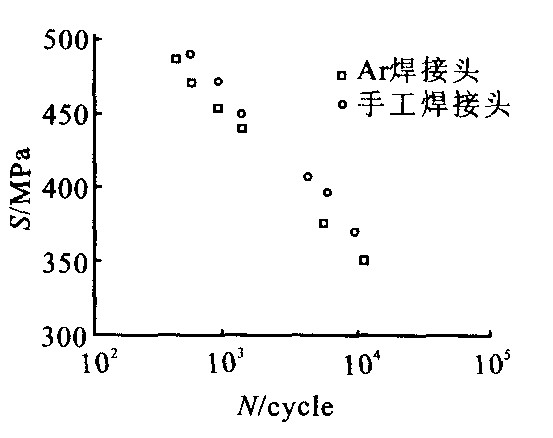Extrapolation of probabilistic fatigue S-N curves on 16MnR steel weld joint
-
摘要: 针对16MnR钢焊接头, 利用现有不同试验条件下的中短寿命试验数据, 采用2m-1指数法, 延拓概率疲劳S-N曲线到长寿命范围。基于Basquin关系, 得到包含存活概率曲线、置信度曲线和两者融合曲线在内的延拓概率疲劳曲线, 在中短寿命范围对试验数据有良好的拟合效果, 在延拓阶段可对长寿命范围作近似预测。该方法可近似合理地对曲线进行延拓, 较直接利用中短寿命S-N曲线延长到长寿命范围的直接法更为合理, 结果表明, 该方法是可行的。Abstract: This paper extended the commonly probabilistic curves of 16MnR steel weld joint into long life regime by 2m-1 exponent method according to the fatigue test data in different test conditions. The curves are constructed by Basquin relations, consisting of survival probability-based curves, confidence-based curves, and survival probability and confidence-based curves. These curves fit the test data well in original regime, can predict the long life regime approximately. The extrapolated effects, which fit into the test data of 16MnR steel weld joint, reveal that the method acts approximately as the function of extrapolation, and it is more reasonable than direct method, which extends original S-N curves into long life regime directly. The results show that the method is feasible.
-
Key words:
- locomotive engineering /
- fatigue /
- S-N curves /
- long life regime /
- probabilistic analysis /
- 16MnR steel /
- weld joint
-
表 1 原始阶段典型P-S-N曲线参量
Table 1. Parameters of typical P-S-N curves in original regime
P AP BP CP mP 0.9 25.337 5 -8.479 95 0.217 5×1026 8.479 95 0.99 21.392 9 -7.056 67 0.247 1×1022 7.056 67 0.999 18.508 9 -6.016 06 0.322 8×1019 6.016 06 0.999 9 16.135 1 -5.159 55 0.136 5×1017 5.159 55 表 2 原始阶段典型C-S-N曲线参量
Table 2. Parameters of typical C-S-N curves in original regime
C/% AC Bav CC mav 90 29.970 9 -10.225 8 0.935 1×1030 10.225 8 95 29.923 8 -10.225 8 0.839 1×1030 10.225 8 99 29.817 3 -10.225 8 0.656 6×1030 10.225 8 表 3 原始阶段典型P-C-S-N曲线参量
Table 3. Parameters of typical P-C-S-N curves in original regime
P C/% AP-C BP CP-C mP 0.9 90 25.132 4 -8.479 95 0.135 6×1026 8.479 95 95 25.085 4 -8.479 95 0.121 7×1026 8.479 95 99 24.978 9 -8.479 95 0.952 5×1025 8.479 95 0.99 90 21.187 8 -7.056 67 0.154 1×1022 7.056 67 95 21.140 8 -7.056 67 0.138 3×1022 7.056 67 99 21.034 3 -7.056 67 0.108 2×1022 7.056 67 0.999 90 18.303 8 -6.016 06 0.201 3×1019 6.016 06 95 18.256 8 -6.016 06 0.180 6×1019 6.016 06 99 18.150 3 -6.016 06 0.141 3×1019 6.016 06 0.999 9 90 15.930 0 -5.159 55 0.851 2×1016 5.159 55 95 15.883 0 -5.159 55 0.763 8×1016 5.159 55 99 15.776 5 -5.159 55 0.597 7×1016 5.159 55 表 4 外推阶段典型P-S-N曲线参量
Table 4. Parameters of typical P-S-N curves in extrapolating regime
P AP BP CP mP S5-6/MPa S8/MPa 0.9 42.510 5 -15.959 9 0.324 0×1043 15.959 9 175.33 145.32 0.99 35.298 2 -13.113 3 0.198 7×1036 13.113 3 151.68 120.70 0.999 30.025 1 -11.032 1 0.106 0×1031 11.032 1 130.13 99.19 0.999 9 25.684 9 -9.319 1 0.484 1×1026 9.319 1 108.97 79.01 表 5 外推阶段典型C-S-N曲线参量
Table 5. Parameters of typical C-S-N curves in extrapolating regime
C/% AC Bav CC mav S5-6/MPa S8/MPa 90 51.152 0 -19.451 5 0.141 9×1052 19.451 5 192.90 165.36 95 51.104 9 -19.451 5 0.127 3×1052 19.451 5 191.83 164.45 99 50.998 4 -19.451 5 0.996 4×1051 19.451 5 189.42 162.38 表 6 外推阶段典型P-C-S-N曲线参量
Table 6. Parameters of typical P-C-S-N curves in extrapolating regime
P C/% AP-C BP CP-C mP S5-6/MPa S8/MPa 0.9 90 42.305 4 -15.959 9 0.202 0×1043 15.959 9 170.21 162.98 95 42.258 4 -15.959 9 0.181 3×1043 15.959 9 169.06 140.13 99 42.151 9 -15.959 9 0.141 9×1043 15.959 9 166.48 137.99 0.99 90 35.093 1 -13.113 3 0.123 9×1036 13.113 3 146.32 116.43 95 35.046 1 -13.113 3 0.111 2×1036 13.113 3 145.11 115.48 99 34.939 6 -13.113 3 0.870 2×1035 13.113 3 142.42 113.34 0.999 90 29.820 0 -11.032 1 0.660 7×1030 11.032 1 124.68 95.03 95 29.773 0 -11.032 1 0.592 9×1030 11.032 1 123.46 94.10 99 29.666 5 -11.032 1 0.463 9×1030 11.032 1 120.75 92.03 0.999 9 90 25.479 8 -9.319 1 0.301 9×1026 9.319 1 103.59 75.11 95 25.432 8 -9.319 1 0.270 9×1026 9.319 1 102.39 74.24 99 25.326 3 -9.319 1 0.212 0×1026 9.319 1 99.73 72.31 -
[1] Stanzle S E, Tschegy EK, MayerH. Lifetime measurementsfor random loading in very high cycle fatigue range[J]. International Journal of Fatigue, 1986, 8(2): 195-200. [2] Lawson L, Chen E Y, Meshii M. Near-threshold fatigue: a review[J]. International Journal of Fatigue, 1999, 21(Supl): 15-34. [3] Murakami Y, Nomoto T, Ueda T. Factors influencing the mechanism of superlong fatigue failure in steels[J]. Fatigue and Fracture of Engineering Material and Structures, 1999, 22(7): 581-590. doi: 10.1046/j.1460-2695.1999.00187.x [4] Hart- Smith L J. An engineer's viewpoint on design and analysis of aircraft structural joints[J]. Journal ofAerospace Engineering, 1995, 209(G2): 105-109. [5] Bathias C. Gigacycle fatigue of high strength steels prediction and mechanisms[A]. In Fracture Mechanics: Applications and Challenges[C]. Elsevier Science Ltd., Amsterdam, 2000. [6] 陈旭, 赵志芳. 16MnR钢焊接接头低周疲劳性能[J]. 化工生产与技术, 2000, 7(3): 10-11. https://www.cnki.com.cn/Article/CJFDTOTAL-HGSC200003002.htmCHEN Xu, ZHAOZhi-fang. Low cycle fatigue characterof 16MnRsteel weld joint[J]. Chemical Production and Technology, 2000, 7(3): 10-11. (in Chinese) https://www.cnki.com.cn/Article/CJFDTOTAL-HGSC200003002.htm [7] 赵永翔, 杨冰, 王金诺, 等. 有限数据下疲劳可靠性设计分析方法与试验研究[R]. 成都: 西南交通大学, 2003. [8] 赵永翔, 高庆, 王金诺. 估计三种常用应力-寿命模型概率设计S-N曲线的统一方法[J]. 核动力工程, 2001, 22(1): 42-52. https://www.cnki.com.cn/Article/CJFDTOTAL-HDLG200101009.htmZHAO Yong-xiang, GAO Qing, WANG Jin-nuo. Unified approach for estimating the probabilistic design S-N curves of three commonly used fatigue stress-life models[J]. Nuclear Power Engineering, 2001, 22 (1): 42-52. (in Chinese) https://www.cnki.com.cn/Article/CJFDTOTAL-HDLG200101009.htm -





 下载:
下载:





